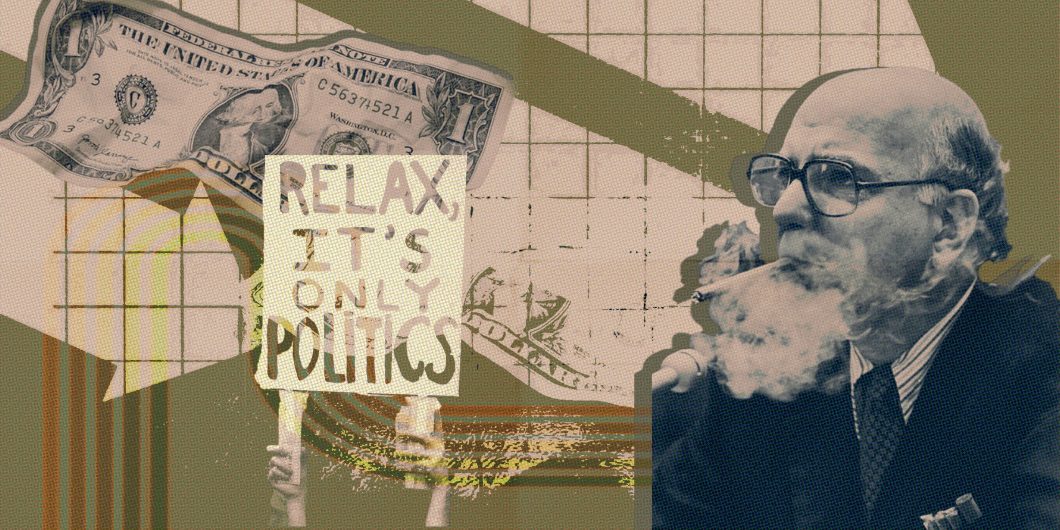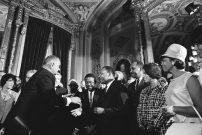Restoring The Fed's Credibility?
If any central banker, both literally and figuratively, bestrode, in Shakespeare’s phrase, “the…world like a colossus,” it was the 6-foot-7 Paul Volcker. But, perversely, the giant shadow he cast helps explain our not-so-transitory inflationary mess.
Alex Pollock offers a brisk, deft analysis of Volcker’s battle against inflation. He sets the stage with a 1979 speech by Arthur Burns, Volcker’s not quite immediate predecessor as Fed Chairman. In what Pollock describes as an “agonizing reappraisal,” Burns conceded (he could hardly do otherwise) that central banks had failed to rein in inflation. Running through his lament was an acknowledgment that the Fed had gone along with “the philosophic and political currents that were transforming American life and culture,” currents that had also swept away traditional notions of fiscal and monetary discipline.
But Burns also recognized that popular sentiment was again shifting. Much of the expansion in government spending during the 1960s and 1970s had not delivered what the public had hoped, but it had given them higher taxes and inflation. Most Americans, maintained Burns, had come to regard inflation as the country’s top problem, so much so that:
even restrictive moves by the Federal Reserve, which not long ago would have stirred anger and anxiety in government circles, have been accepted with equanimity. Symbolic of the changed political atmosphere was the announcement of an increase in the Federal Reserve discount rate on the very day…when a sizable decline of the nation’s overall spring production was being reported for the spring quarter.
The timing (July 20, 1979) of that rate hike is worth noting for another reason. It predates Volcker’s time at the helm, although barely. Less than a week later, Volcker, whose hawkish views were no secret, was nominated by President Carter to the chairmanship. The political currents had indeed changed course.
Burns claimed to be encouraged by the “present widespread concern about inflation” but fretted that U.S. policymakers’ preference for “gradualism” would open the door to backtracking. If the “inflationary psychology” that had taken hold was to be routed, it would take “fairly drastic therapy.” As Pollock notes, “this was correct except for the modifier ‘fairly.’” Burns doubted whether many central bankers would be able to see through the necessary “painful economic adjustments.” The somewhat bleak consolation: After “false starts” the “learning process [would] be speeded,” and better policies would finally be put in place, “unless political leadership falls into irresponsible hands,” words that resonate unhappily today.
Within weeks of his appointment in August 1979, Volcker made his intentions clear in testimony to Congress, testimony that was sandwiched between two rate hikes. As Pollock mentions, a week or so later, Volcker repeated a key theme from that testimony—that fixing inflation was a precondition of the economy’s return to good order—on network TV. It was not enough for there to be a new sheriff in town. People had to know he meant business. With inflationary expectations widely embedded across the U.S., that news had to reach Main Street as well as Wall Street.
Early in his tenure, after continued market skepticism confirmed that a new approach was called for, Volcker abandoned any remnants of gradualism. The discount rate was increased by 100 bp in October 1979, and the central bank switched its focus away from tweaking the fed funds rate to (as recounted in the Fed’s history) “managing the volume of bank reserves in the system,” a change Volcker puts into context in his autobiography.
At the “heart of the matter,” wrote Volcker, there was “a commitment to restrain growth in the money supply whatever the implications might be for interest rates.” They soared, Pollock relates, “[and became] strongly positive in real terms,” which “under the cover of restricting the growth in the money supply” may, he speculates, have been the idea all along. Not without cause, Pollock suggests Volcker was unpersuaded by monetarism. Just how unpersuaded is a topic for another day, but the tack taken by the Fed in pursuit, at least nominally, of monetarist goals and, crucially, a willingness to stick with it through some very tough patches was, along with astute messaging, sufficient to do the trick.
By the time Volcker left office in August 1987, the Great Inflation had been cut down to size, the fed funds rate had come down sharply, and real GDP growth was humming along. But Pollock is right to remind us that inflation (then at 4 percent) was still “endemic,” something that can, arguably, be seen in the way that 30-year bond rates held up (after two sharp declines) for some years thereafter.
It’s easy to see how the Fed might blink, condemning us to a rerun of the 1970s, or something grimmer still.
It was only in the happy interlude between 1993 and 1997 that inflation could, broadly speaking, have been said to have been tamed. Even then, as Volcker knew full well (and Pollock would, I’m certain, agree), it had not been safely consigned to the coffin. While I share neither Volcker’s wishful thinking about fixed exchange rates (nor, if I read him correctly, Pollock’s regrets over the break-up of the Bretton Woods system) there is no denying that the price of a fiat currency is—or, more accurately, ought to be—eternal vigilance against inflation.
And so, Pollock explains, Volcker had grave reservations about the Fed formally targeting 2 percent inflation. Volcker’s objections, which are set out in his autobiography, were both logical (among them that “it’s difficult to be both a target and a limit at the same time”) and illustrative of the way that he believed that price stability should mean just that. A “2 percent inflation rate, successfully maintained would mean,” wrote Volcker disapprovingly, “that the price level doubles in little more than a generation.” Perhaps that’s to let the perfect be the enemy of the good enough (there’s some value in an easily understandable target), but Volcker was nothing if not, as Pollock puts it, an “ardent anti-inflationist.”
A central bank will find it far easier to control inflation if its determination to do so is believed. No small part of the credit for the low inflation that followed Volcker’s chairmanship is due to his restoration of the Fed’s credibility, a credibility that, in a virtuous circle, was reinforced by his successors’ success (with the assistance, to be sure, of favorable economic and political tailwinds) in keeping inflation subdued in the years that ensued. And that credibility, however battered it may have been in other respects by recriminations over the global financial crisis, was sturdy enough to ensure that the Fed could play a vital role in helping the U.S. weather that storm.
That, to the surprise of quite a few, the country was spared an inflationary surge—as conventionally measured: Some asset prices need to be put to one side—in the economically still only half-understood years after the crisis bolstered still further confidence in the Fed’s ability to manage inflation, confidence that, behind the Fed’s walls, ultimately mutated, I suspect, into hubris. If so, that would surely have contributed to the central bank’s decision in August 2020 to adopt flexible average inflation targeting, a methodology that Volcker would have detested. The idea of allowing the economy to “run hot” so that inflation could hit an arbitrarily determined target would have struck him as both intellectually absurd and profoundly dangerous: Opening Pandora’s box “just for a little while” is not normally the best way to go.
That initiative ought to have cast doubt on the Fed’s reliability as an inflation fighter—for those paying attention anyway. Under the circumstances, mounting evidence that the central bank might be susceptible to the temptations of mission creep—most notably where climate change is concerned—is not particularly reassuring either. Despite his own worries about climate change, the father of the Volcker Rule, a man who attached enormous importance to organizations staying within their institutional remit, would have been appalled. Above all, of course, he would have been angered by the Fed’s sluggish and complacent reaction to growing inflation last year, a blunder that has made a bad situation worse and, by damaging the central bank’s credibility, weakened its capacity to respond.
So, what now? Pollock duly points out that, even after recent increases, interest rates are still negative in real terms, and thus “hardly Volckeresque,” but he wonders how high the Powell Fed will be prepared to drive them. Pollock quotes commentary highlighting how the political and economic zeitgeist has changed between 1979 and 2022. It’s not cheerful reading. I also share his unease over the impact of more expensive money on borrowers in both the private and public sectors who have grown to depend on the ultra-low interest rates of the last decade.
And, lest we forget, the ratio of government debt to GDP has grown from a little over 30 percent in 1979 to around 125 percent now. That latter number alone (which understates the fiscal perils America faces, given coming shortfalls in Social Security and other entitlement programs) has frightening implications if anything remotely “Volckeresque” is needed to see off inflation. Put all this together, and it’s easy to see how the Fed might blink, condemning us to a rerun of the 1970s, or something grimmer still.
“There is,” writes Pollock, “now no avoiding pain, which will come in one way or the other.” It’s difficult to disagree.


